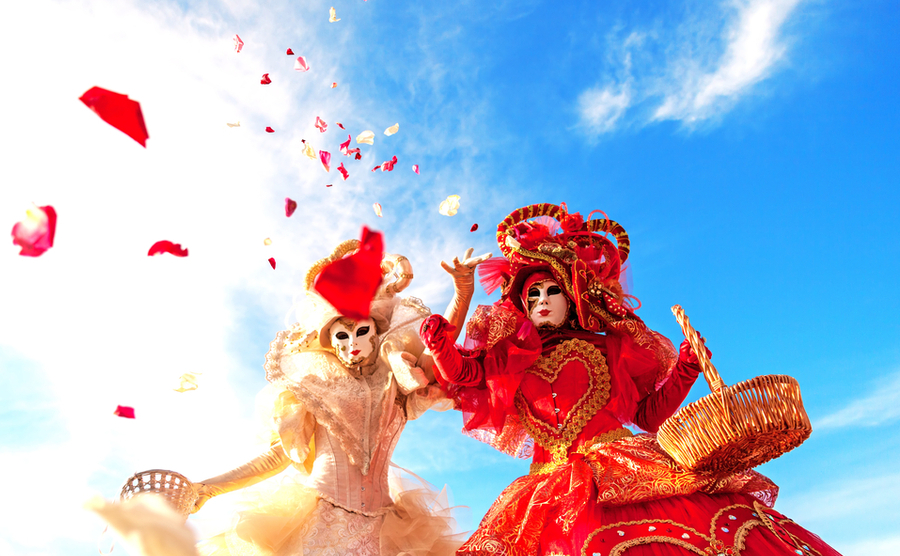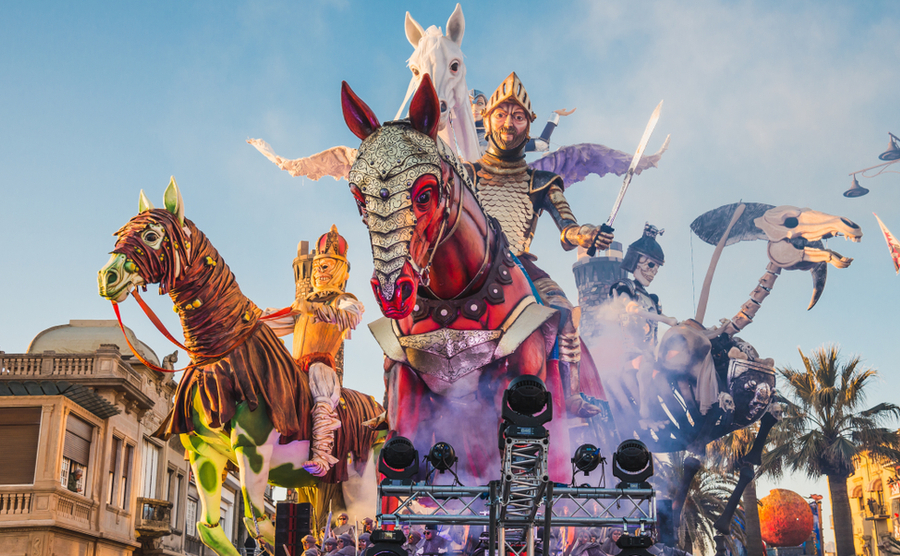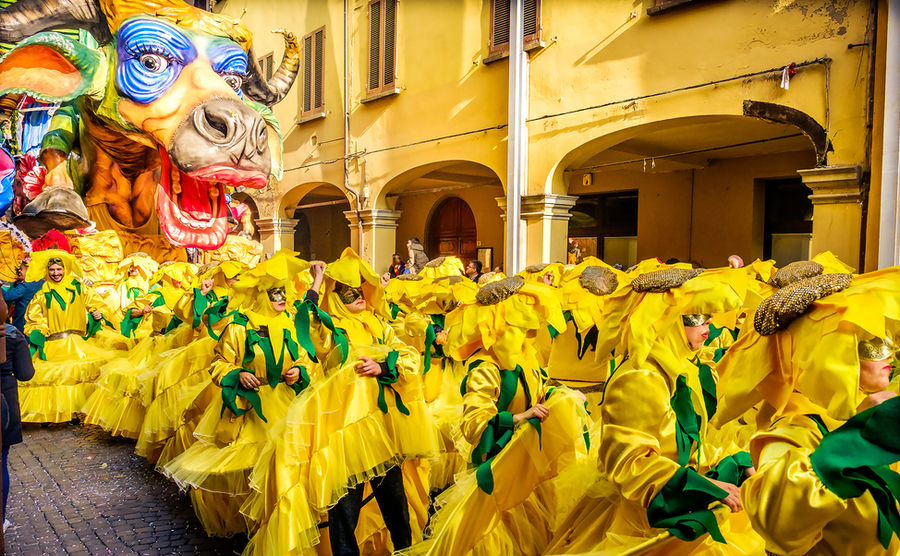The Italian Carnival brings the party to winter with huge colourful floats and costumes. So, grab a mask and some confetti and join in the fun in one of Italy’s favourite Carnival towns.
Carnival, or Carnevale in Italian (pronounced car-knee-var-lee), is a national celebration which takes place across the country 40 days before Easter, the day before Lent begins. Venice hosts the most famous Carnevale in Italy, but they take place all across the country every year on Shrove Tuesday (also Pancake Day!).
Carnival celebrations
As the Carnival is often celebrated in late February or March in Italy, it’s a great way to brighten the coldest days with parades, masquerade balls, floats, entertainment, music, confetti, parties and of course costumes and masks (Maschere).
There are lots of fun activities for children, and even the little ones dress up and throw confetti at the passing carnival floats. Grandmothers get out their sewing machines to create original outfits for their grandchildren. Then, after being worn once, they might end up in the second-hand clothes section of the weekly market. At the end of January, you will find many children’s costumes for sale.
Carnival events and processions of various sizes are held all across Italy. A small town that hardly sees any visitors all year, might be crowded during carnival month. It is a testament to the community spirit of the local people. They spend much of their free time, organising activities for the children, arranging the music and making floats, costumes and masks. There is always something to entertain all ages.
Some towns do more than others, and Carnival isn’t just about a parade. Some might concentrate on parties for community groups, activities for the children and cooking carnival food. While those that have talented artists able to work with paper-mâché might build amazing floats. Most regions will have at least one spectacular parade that thousands travel to.
Find homes in Italy via our property portal.
The 5 best Italian carnivals
1. Viareggio Carnival, Tuscany
The Carnival in Viareggio on the coast of Tuscany attracts more than 600,000 spectators each year. The festivities last all month, with night and day celebrations, floats, parades, masked balls and shows.
Slowly the parade travels past beautiful Art Deco buildings and along the Liberty Seaside Boulevard. You have to be there to appreciate the sheer size of the floats. Some are over 20 metres high. People lining the streets are wowed by the work that has gone into these amazing creations. Towering as high as the buildings, they even have moving parts.
Local artists dedicate themselves to the creation of these enormous allegorical paper-mâché works of art. Using satire and allegory, each float represents a theme from society and the world. For example, subjects included in the 2024 floats include artificial Intelligence, polluted oceans, and consumerism.
Viareggio
Viareggio is the best-known seaside town on the Versilia coast of Tuscany. It is also the second-largest town in the province of Lucca, with a population of over 60,000. Viareggio also boasts 10 kilometres (6.2 miles) of sandy beaches, of which 6 kilometres (3.7 miles) are managed by private beach resorts and the remaining 4 kilometres (2.5 mi) are public.
2. Cento Carnival, Emilia Romagna
The Cento Carnival, in the Emilia Romagna region, is twinned with the Rio de Janeiro Carnival in Brazil. The carnival is dedicated to the arts, crafts and traditions of the area, with floats of a very high quality. In fact, the winning float in the Cento parade is taken to Brazil to take part in their Carnival.
Throughout the month of Carnival, the magnificent medieval village of Cento is filled with many events. Highlights include the local food, wine, art, dance, and culture, that can also be experienced year round.
The party concludes with an exciting pyro-musical show, with lively bands. To celebrate the historic twinning with the famous Rio de Janeiro Carnival, the town also invites a group of Brazilian dancers and percussionists to perform.
Cento
The town of Cento is in the province of Ferrara but is only 25 km from Bologna and 38km from Modena. This small artistic, culinary and economic centre has a population of around 36,000. The old town is beautifully preserved with monuments, art treasures and long porticos typical of the Po Valley. An imposing fortress with massive towers dominates the town.
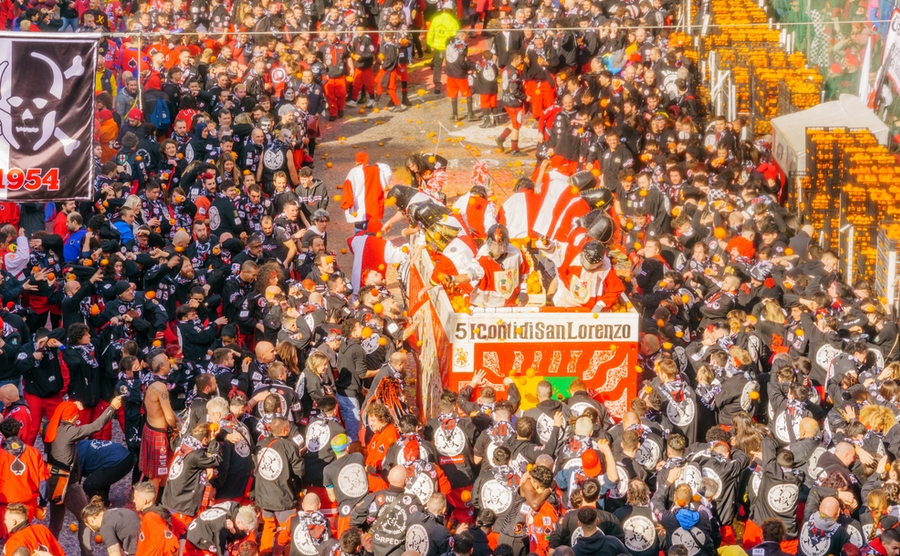
Battle of the Oranges, part of the historical carnival of Ivrea, Piedmont, Northern Italy
Image: RnDmS via Shutterstock
3. Ivrea Carnival, Piedmont
The town of Ivrea, in the Piedmont region, has a unique carnival celebration with a colourful parade followed by an orange-throwing street battle. The spectacular Battle of the Oranges is an exciting moment of strong emotions commemorating the people’s rebellion against tyranny.
Dating back to 1808, Ivrea’s Carnival is full of history and myth. This exhilarating community celebration is full of symbolism and traditional values. Although Ivrea Carnival is most famous for the Battle of the Oranges, the hero of the carnival is the Vezzosa Mugnaia (Miller’s Daughter).
The story behind Ivrea’s Carnival tells of an uprising of the people against the Marquis of Monferrato. As well as oppressing the town he insisted new brides must sleep with him. However, the Miller’s daughter resisted and killed him, thus triggering an uprising. She now plays the starring role in the carnival.
Ivrea
Ivrea has a historic centre nestled on a hillside dominated by the four towers of the Arduino castle. The municipality of Ivrea has over 22,000 inhabitants in the metropolitan city of Turin in Piedmont. However, it is the Olivetti factory that has created the town’s unique character. It is the “Ivrea industrial city of the 20th century” that was awarded UNESCO World Heritage Status. An award that recognises the “humanisation” of industrial and social areas. A model that has now become a historical, cultural, social and ethical heritage to be admired.
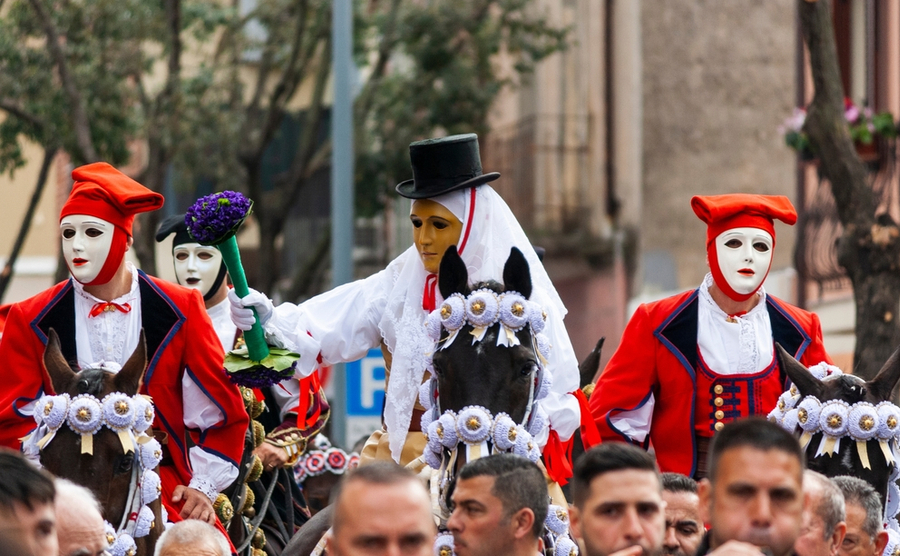
Componidori parades in the procession of Oristano’s traditional carnival: Sa Sartiglia
Image: Marco Cuccu via Shutterstock
4. Oristano Carnival, Sardinia
The town of Oristano, in Sardinia, celebrates Carnevale with a costumed parade, horse races and a re-enactment of a medieval jousting tournament. An important part of rural life on Sardinia is horses. Therefore, they feature in many equestrian events during Carnival.
The most ancient and spectacular equestrian event is the Sartiglia in Oristano. Sartiglia has its roots in the period of Spanish domination and has been celebrated every year since 1546. On Carnival Sunday as many as 100 horse riders take turns to gallop full speed down Via del Duomo to try and pierce the star. The horse and rider are decoratively dressed and the rider wears a creepy plain mask.
Afterwards, they gather in groups of three, called “Le Pariglie”, to perform acrobatic stunts. These incredible performances are done at high speed and on horseback. The atmosphere is further heightened by the accompaniment of the drummers and trumpeters.
Oristano
Oristano is located in central-western Sardinia, in a great central location for exploring the area. The population of over 30,000, enjoy the grande shopping streets, elegant piazzas, popular cafes and restaurants. At its heart is Piazza Eleonora, with its statue of Eleonora d’Arborea. Nearby, is Piazza Roma, which boasts further shops, cafes and a tower.
Carnival on Sardinia
All across the island of Sardinia, Carnival celebrations have roots buried deep in ancient pagan rites. Celebrations in the Sardinian towns are performed in many different ways. You might see bonfires and musicians playing tambourines. Or, traditional masks and costumes representing rural life.
Deep in the heart of Sardinia they dress in black sheepskins and hide their faces behind grotesque wooden masks with cowbells carried on their backs. While Issohadores wearing red shirts and white masks attempt to capture the grotesque animal-masked people with a lasso.
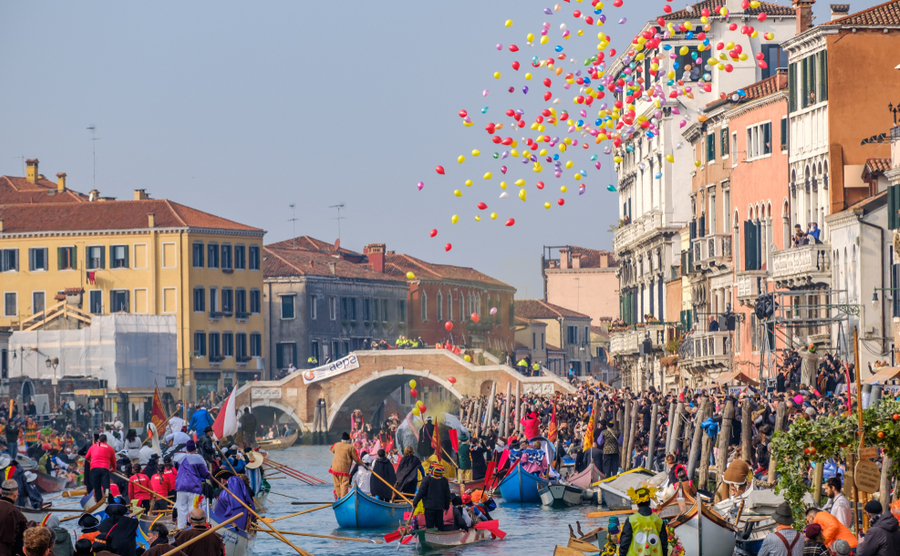
The traditional parade of the Venetian masks at the Carnival
Image: Gentian Polovina via Shutterstock
5. Venice Carnival, Veneto
We can’t talk about carnivals in Italy, without mentioning Venice. The Venice Carnival, is an extravagant combination of gondolas, masks and mysterious people dressed in elaborate costumes.
Masks are a big part of the Carnival celebrations. It’s possible to buy one from stalls and shops in Venice all year round. People from all walks of life put on a mask and immediately transform into whoever they dream of being. Confident, extravagant, mysterious and at the same time a little scary, these masked individuals are a posing photo opportunity for the thousands of visitors in St Marks Square. During the Carnival, there are also street entertainers, masquerade balls and a grand firework display.
In the 2024 edition, the extraordinary journey of Marco Polo is celebrated. To mark the 700th anniversary of his death, the theme of the Venice Carnival is the discovery of other, previously only imagined worlds. In addition, it is a journey and quest to find oneself and to discover that we are different from when we first left.
Marco Polo travelled to unknown places by land and returned to Venice by sea, gathering an incredible amount of information, meeting extraordinary characters and gaining access to a very exclusive world. When faced with the wonders of the unknown, we are the same now as he was 700 years ago. It is still exhilarating to take a journey to a place we have never seen before, experience a different culture, taste the food, and enjoy the music.
Venice
Some people dream of living in Venice, with its romantic gondolas gliding through picturesque canals and elegant architecture. Like anywhere, it has its pros and cons. The crowds of tourists can be overwhelming, especially near the main landmarks, such as Piazza San Marco and the Rialto Bridge. However, those who have lived here a while soon learn how to navigate the quieter pedestrianised streets.
There are numerous restaurants, cafes, and bars scattered throughout the city, serving traditional Venetian recipes using fresh, local ingredients, particularly seafood and fish-based dishes. Get up early, and you can visit the Rialto fish market, buy fresh vegetables, sip coffee at a café, and take a stroll before the tourists arrive. However, many locals now live further out, where accommodation is cheaper and they can simply catch a waterbus in to work.
In Italy, there is so much to discover and enjoy, that you can easily set up base here and spend the rest of your life just exploring the wonders of this beautiful land. As well as carnivals, there are numerous cultural events, from festivals to celebrate the town’s patron saint, to food and wine festivals.


